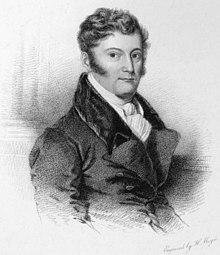Prince Maximilian of Wied-Neuwied | |
|---|---|
 Prince Maximilian of Wied-Neuwied | |
| Born | 23 September 1782 |
| Died | 3 February 1867 (aged 84) Neuwied, Kingdom of Prussia |
| Nationality | German |
| Relatives | Wied-Neuwied |
| Scientific career | |
| Fields | Ethnology Natural history |
Prince Alexander Philipp Maximilian zu Wied-Neuwied (23 September 1782 – 3 February 1867) was a German explorer, ethnologist and naturalist. He led a pioneering expedition to southeast Brazil between 1815 and 1817, from which the album Reise nach Brasilien, which first revealed to Europe real images of Brazilian Indians, was the ultimate result. It was translated into several languages and recognized as one of the greatest contributions to the European knowledge of Brazil at the beginning of the nineteenth century. In 1832 he embarked on another expedition, this time to the United States, together with the Swiss painter Karl Bodmer.
Prince Maximilian collected many examples of ethnography, and many specimens of flora and fauna of the area, still preserved in museum collections, notably in the Linden Museum, Stuttgart.[1] The genus Neuwiedia Blume (Orchidaceae) was named for him. Also, Prince Maximilian is honored in the scientific names of eight species of reptiles: Hydromedusa maximiliani, Micrablepharis maximiliani, Bothrops neuwiedi, Polemon neuwiedi, Pseudoboa neuwiedi, Sibynomorphus neuwiedi, Xenodon neuwiedii, and Ramphotyphlops wiedii.[2]
- ^ Wilson, J. G.; Fiske, J., eds. (1900). . Appletons' Cyclopædia of American Biography. New York: D. Appleton.
- ^ Beolens, Bo; Watkins, Michael, Grayson, Michael (2011). The Eponym Dictionary of Reptiles. Baltimore: Johns Hopkins University Press. xiii + 296 pp. ISBN 978-1-4214-0135-5. ("Maximilian", p. 171; "Neuwied", p. 189; "Wied", p. 285).